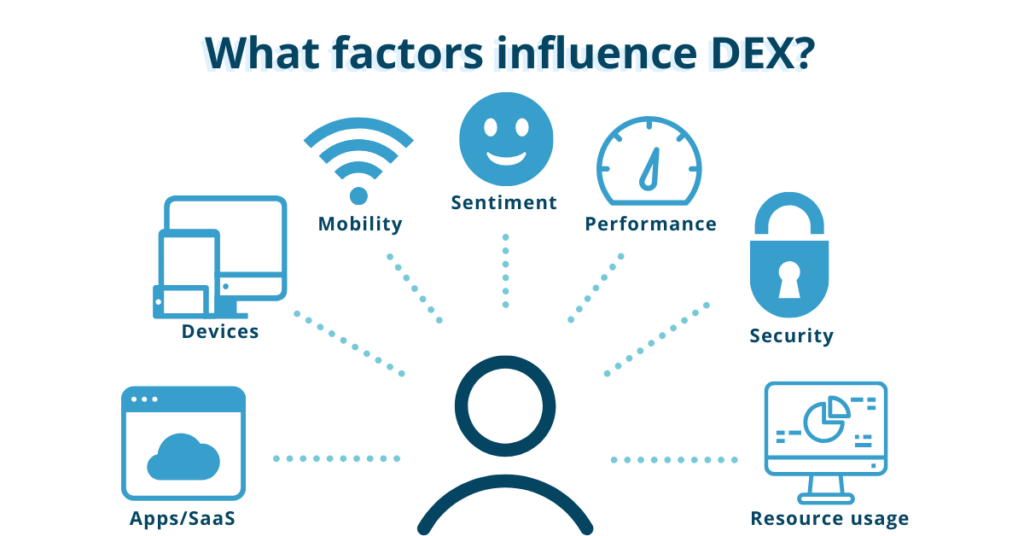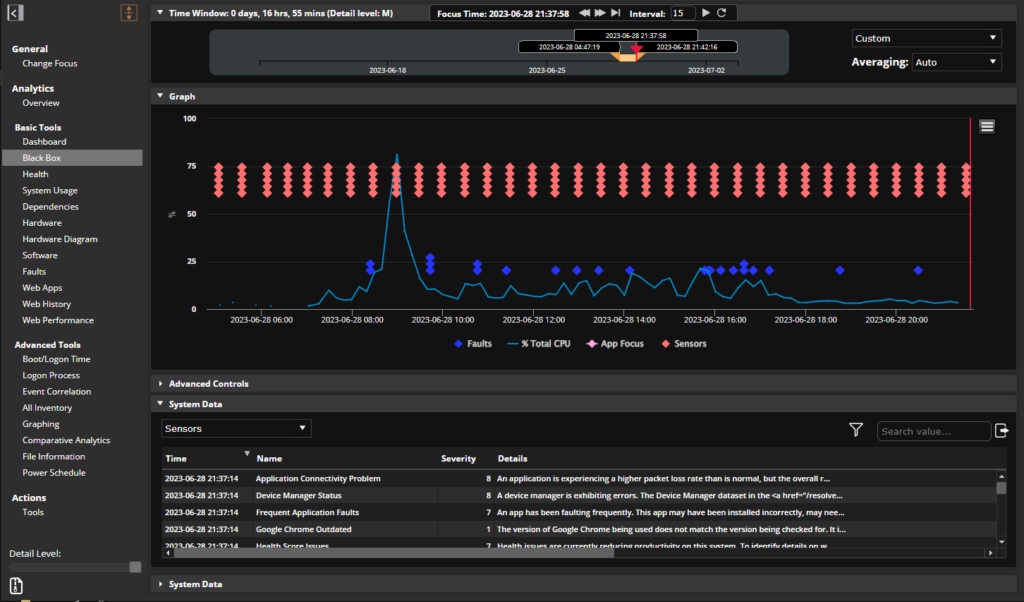
Every new technology and workplace innovation comes with high expectations and even a sense of hope. Because maybe — just maybe — this will be the thing to help people do more and do it better.
Yet few things are ever that perfect.
Even at a time when people can work from anywhere on any number of devices, technical difficulties still happen. System infrastructures, workflows, and cloud services aren’t without fault. And when a slow connection or long loading time hits, the simplest task becomes much harder than it needs to be.
But doing a job doesn’t always have to be so much work. Not if organizations take a more dynamic approach to their digital environments and prioritize their end users.
Because although not every piece of technology or innovation may be perfect, overall digital employee experience can still be great.
What Is Digital Employee Experience (DEX)?
Digital Employee Experience (DEX) is the quality of users’ interactions with technology in their work environment.
Every workplace is full of circumstances, from onboarding new hires to accommodating flexible work schedules, that affect the way people think and feel about an organization. According to Gartner research, “a Gartner survey revealed that only 13% of employees are fully satisfied with their experience.”[1]
But digital employee experience (DEX) — sometimes referred to as end-user experience (EUX) — focuses mainly on the technical side of things. It defines the quality of users’ interactions with the workplace technology they need to do their jobs and looks at how system performance and usage impact productivity.
Common issues that affect DEX include:
- Slow computer or program startups
- Apps that suddenly crash
- Network connection issues
- Outdated hardware and software
Although DEX might be a trendier term that’s emerged in the last couple years, the underlying concept has been reshaping IT departments for much longer. As digital transformation makes technology and users more complex — with more mobile devices, cloud-based apps, and a shift to remote work — IT continues to adapt to meet end users’ many needs.
And meeting those needs not only makes experiences better, but also greatly benefits organizations.
5 Benefits of a Great Digital Employee Experience
Knowing about DEX is one thing. But understanding how employee satisfaction can improve organizations is just as important.
Because at the end of the day, a great employee experience means a great deal.
Here are a few of the main benefits:
1. Happier and more productive end users
Nothing makes people happier than a hassle-free experience. And when employees are happy, it shows in their work.
In fact, a recent research paper published by the University of Oxford’s Saïd Business School showed a 13% increase in productivity among happy workers.
“There seems to be considerable room for improvement in the happiness of employees while they are at work,” noted Oxford Associate Professor Jan-Emmanuel De Neve, one of the authors of the paper. “While this (is) clearly in the interest of workers themselves, our analysis suggests it is also in the interests of their employers.”
Enterprises are slowly catching on to the notion that employee satisfaction is critical — especially when it comes to digital transformation initiatives. Forty-four percent of responding executives consider increasing employee efficiency and productivity key in their organizations’ digital strategies, according to a 2018 survey written by the Economist Intelligence Unit.
Because when it comes to fulfilling business goals and driving better outcomes, happy workers make all the difference.
2. Better retention and recruiting
A great digital experience isn’t merely a nice side benefit — it’s become a cultural norm and major job consideration.
For Gen Zers, a deeply technology-driven and growing part of the modern workforce, substandard digital workplaces are likely to be deal breakers, according to a recent Dell Technologies study. Eighty percent of those surveyed aspire to work with cutting-edge technology while a whopping 91% said technology would influence their job choice among similar employment offers.
So to become the kinds of places where employees and potential hires want to work, companies are having to rethink their approach to digital development.
Among the most critical changes organizations are looking to make, 31% of respondents pointed to working with clients and employees to leverage digital offerings, according to the Economist Intelligence Unit survey. Another 29% also consider recruiting more digital-savvy employees and consultants essential for their future growth.
“We want digital talent who are deeply digital in their soul,” said Jon Carney, CDO EMEA at McCann Worldgroup, in the survey. “They need to have a broad understanding of communications, but the important thing is that they have a passion about digital solutions that we can all deploy and use.”
3. Fewer support tickets
No one actually enjoys filing support tickets. Especially if the mean time to resolve (MTTR) incidents takes several hours and ends up requiring multiple points of contact.
Luckily, there’s another way.
When digital workplaces are equipped and maintained with end-user experience in mind, everything else soon falls into place. Digital employee experiences are better, workers are happier and more productive, and incidents become fewer and further between.
That means less time — and money — spent solving support tickets.
4. More IT innovation
When IT teams aren’t bogged down with fixing extensive problems and resolving endless tickets, they can focus on opportunities that deliver greater business value instead. Because although delivering great DEX is a continual and demanding process, taking operations to the next level helps meet those end-user needs while also freeing up enough time and resources to make those wish list projects a reality.
This could include cloud migrations, investments in new technology, automation, integrations, or other trending innovations — all of which keep organizations agile and competitive as well as enhance digital experiences.
5. Greater savings for organizations
Being mindful of what end users are experiencing and giving IT departments the tools they need to monitor, support, and even predict potential problems can increase the ROI in the long run.
And a better workforce can also mean higher rates of customer satisfaction that improve stock market valuations, based on a 2019 Glassdoor study.
Bottom line: A great digital employee experience is good for any enterprise’s bottom line.
How to Measure Digital Employee Experience
When it comes to evaluating DEX, there are a couple ways to go about it.
The most straightforward would be to simply ask employees about their experiences. End-user feedback can be valuable for identifying general problems within the digital workplace — including the issues employees think are the most important to address.
But a subjective viewpoint isn’t easily quantified and measured. And it can’t pinpoint problems with system performance or resource usage as accurately as objective data.
That’s where digital experience monitoring (DEM) can help.
Using DEM gives organizations greater visibility into their computing environments, either in real-time or with trend histories, by continuously gathering vital system and end-user data right from the endpoint.
Some of those details might include:
- Latency time
- Network saturation
- App performance
- CPU usage
Any one of these data points could greatly help IT departments identify, track, or even predict potential problems affecting end-user experience. But combined they create a much larger, more insightful picture of how technology impacts workforce productivity and where there are opportunities for improvement.
What Is a Digital Employee Experience Score?
So once you have all this raw data collected, then what? How do you piece together and translate everything into a useable strategy that boosts digital employee experience?
By analyzing all those data points and considering what factors affect employee experiences the most, you’ll be able to calculate one of the most critical IT metrics: A DEX score.
| EUX Score | Average Productivity Impact* |
|---|---|
| Excellent 97%+ | 98.5% – 0.6 hours per week |
| Good 90-97% | 93.5% – 2.6 hours per week |
| Fair 80-90% | 83% – 6 hours per week |
| Poor 80% and below | 70% – 12 hours per week |
Figure 1: Average productivity impact at different EUX levels based on Lakeside customer data
*Per employee working at a computer 40 hours/week
For Lakeside’s digital experience monitoring solution, SysTrack, this score represents the overall health of an organization’s digital work environment as well as the impact on employee productivity during a typical work week.
By looking at the scores featured on SysTrack’s dashboards, IT can determine at a glance the overall end-user experience within the digital environment and observe how it trends over time. Then, using those scores as a guide, IT teams can dig deeper to find fixes and system changes that will ultimately enhance employee experiences.
Digital employee experience trend and impacts for the overall environment
These kinds of findings can also help organizations make broader decisions about how digital environments are structured and rationalize necessary investments, including hardware or software upgrades; migrations to virtual desktops; or integrating new services and tools.
But of all the ways enterprises can use these scores or the countless changes they inspire, the end result should at least be the same: A digital employee experience that gets better and better.
[1] Gartner “Improve the Employee Experience,” 2020. https://www.gartner.com/en/human-resources/insights/employee-experience
Subscribe to the Lakeside Newsletter
Receive platform tips, release updates, news and more





